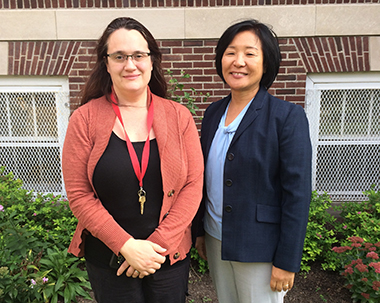Heart to Heart at Home
 |
|
Authors of the new study on the impact of in-home visits on breastfeeding are Sandra McGinnis, left, CHSR senior research scientist, and Eunju Lee, assistant professor of Social Welfare. (Photo by Sarah O'Carroll) |
ALBANY, N.Y. (September 27, 2017) — Breastfeeding protects against infection, lowers the risk of obesity and aids in cognitive development, among other positive results. Why, then, do so many mothers opt out, choosing instead to rely on formula foods?
It’s a tricky — and high-stakes — question, especially when factors such as race and class are factored. A team of UAlbany researchers found data that could point to the solution.
The researchers found that the number of times a home visitor (also known as a family support worker) addresses the subject of breastfeeding during a home visit directly correlates with the likelihood that mothers will attempt, or re-attempt, to breastfeed.
“It’s a simple message: If you talk about it, [mothers] will try to initiate breastfeeding,” said Eunju Lee, assistant professor in the School of Social Welfare.
The study involved more than 3,500 at-risk pregnant women participating in Healthy Families New York (HFNY), a state-wide home visiting program.
If the mean number of visits addressing breastfeeding increases by 10 percent, the mother’s likelihood of breastfeeding increases by 15 percent, said Sandra McGinnis, senior research scientist at the school’s Center for Human Services Resources (CHSR).
“I think it’s compelling to know that the behavior of the home visitor, in terms of initiating these discussions, does make a difference for this group,” McGinnis said. “Some of their issues are rather intractable, so seeing any positive outcomes with such a vulnerable population is noteworthy.”
This linkage of home visits and the likelihood of breastfeeding is independent of ethnicity, education, income and other factors that would generally predict breastfeeding outcomes. This is significant, as these determinants play a big role in a mother’s decision whether to breastfeed, according to McGinnis.
“Even though [breastfeeding] is a mother’s instinctual behavior, there are huge disparities due to race, age and most likely social class,” McGinnis said. “It’s a tremendously difficult task to encourage [at-risk mothers] to breastfeed, but sending the right message does help improve these statistics.”
Four of every five mothers included in the study was unmarried and 40 percent had not finished high school.
Home Visitors as ‘Health Brokers’
During the prenatal period, FSWs made biweekly visits, increasing to weekly visits following a child’s birth and until the child was six months old. This kind of support is often lacking in at-risk households, which helps to explain the behavioral divide between breastfeeding and non-breastfeeding mothers.
And it’s not enough to simply talk about breastfeeding. Tailoring a conversation to individual needs is key, Lee said.
“This is a concept that HFNY likes to call a ‘cultural broker,’ but in the same way, [home visitors] are health brokers; they are helping mothers digest important messages,” she said. “They are saying, ‘What are your worries?’”
To facilitate understanding and to minimize judgment, HFNY home visitors ideally come from the same cultural background and geographic area as the community they serve, McGinnis said.
“It’s not just pushing [mothers] to breastfeed, but a good home visitor will help them with problem solving,” she said.
There are 35 HFNY programs dispersed throughout the state, in both rural and urban areas, including New York City.
The Nexus between Research and Application
A larger objective of the study is not only to analyze data, but to make real improvements in how the HFNY program and programs like it are implemented, Lee said.
“We are not only interested in generating knowledge,” she said. “What it’s really about, especially with social service research, is how are we going to improve people’s lives?”
McGinnis said that improving breastfeeding rates among at-risk mothers can be a stepping stone to tackling other important health topics such as vaccinations, infant mortality rate and safe sleep.
“This particular message is about breastfeeding, but I think the implication here is that home visiting programs are one mechanism by which disadvantaged families can be reached with public health messages,” she said.
* * * * * *
The research team for the study also included Kristen Kirkland and Claudia Miranda-Julian, research scientists at the New York State Office of Children and Family Services, and Rose Greene, director of the Center for Human Services Research at the University at Albany.
![]() For more news, subscribe to UAlbany's RSS headline feeds
For more news, subscribe to UAlbany's RSS headline feeds
A comprehensive public research university, the University at Albany-SUNY offers more than 120 undergraduate majors and minors and 125 master's, doctoral and graduate certificate programs. UAlbany is a leader among all New York State colleges and universities in such diverse fields as atmospheric and environmental sciences, business, education, public health,health sciences, criminal justice, emergency preparedness, engineering and applied sciences, informatics, public administration, social welfare and sociology, taught by an extensive roster of faculty experts. It also offers expanded academic and research opportunities for students through an affiliation with Albany Law School. With a curriculum enhanced by 600 study-abroad opportunities, UAlbany launches great careers.


